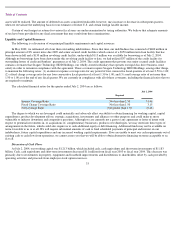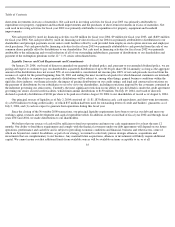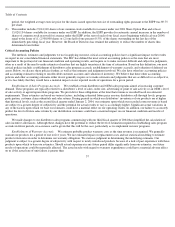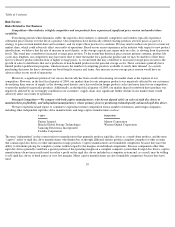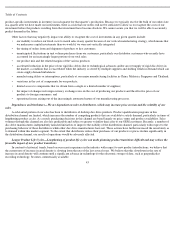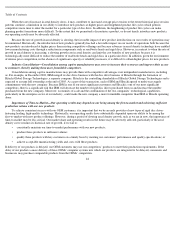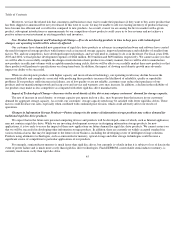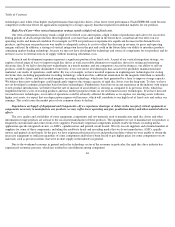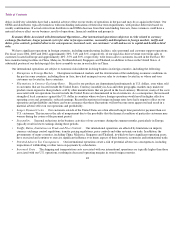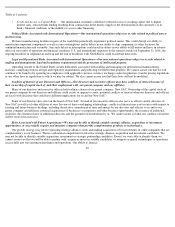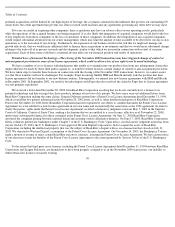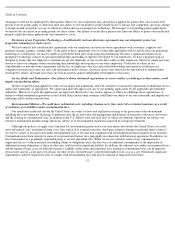Seagate 2003 Annual Report Download - page 43
Download and view the complete annual report
Please find page 43 of the 2003 Seagate annual report below. You can navigate through the pages in the report by either clicking on the pages listed below, or by using the keyword search tool below to find specific information within the annual report.
Table of Contents
continue to look at opportunities for further cost reductions, which may result in additional restructuring activities in the future. We cannot
assure you that our efforts will result in the increased profitability, cost savings or other benefits that we expect. Moreover, the reduction of
personnel and closure of facilities may adversely affect our ability to manufacture our products in required volumes to meet customer demand
and may result in other disruptions that affect our products and customer service. In addition, the transfer of manufacturing capacity of a
product to a different facility frequently requires qualification of the new facility by some of our OEM customers. We cannot assure you that
these activities and transfers will be implemented on a cost-
effective basis without delays or disruption in our production and without adversely
affecting our customer relationships and results of operations.
Industry Demand—Changes in demand for computer systems and storage subsystems has caused and may cause in the future a
decline in demand for our products.
Our rigid disc drives are components in computers, computer systems and storage subsystems and consumer electronic devices. The
demand for these products has been volatile. In a weak economy, consumer spending tends to decline and retail demand for PCs and consumer
electronic devices tends to decrease, as does enterprise demand for computer systems and storage subsystems. During economic slowdowns
such as the one that began in 2001, demand for rigid disc drives, particularly in the enterprise sector was adversely impacted as a result of the
weakened economy and because enterprises shifted their focus from making new equipment purchases to more efficiently using their existing
information technology infrastructure through, among other things, adopting new storage architectures. Unexpected slowdowns in demand for
computer systems and storage subsystems generally cause sharp declines in demand for rigid disc drive products.
Additional causes of declines in demand for our products in the past have included announcements or introductions of major operating
system or semiconductor improvements or changes in consumer preferences, such as the shift from desktop to notebook computers. We believe
these announcements and introductions have from time to time caused consumers to defer their purchases and made inventory obsolete.
Whenever an oversupply of rigid disc drives causes participants in our industry to have higher than anticipated inventory levels, we experience
even more intense price competition from other rigid disc drive manufacturers than usual.
Seasonality—Because we experience seasonality in the sales of our products, our results of operations will generally be adversely
impacted during our fourth fiscal quarter.
Because sales of computer systems, storage subsystems and consumer electronics tend to be seasonal, we expect to continue to
experience seasonality in our business as we respond to variations in our customers’ demand for rigid disc drives. In particular, we anticipate
that sales of our products will continue to be lower during our fourth fiscal quarter than the rest of the year. In the desktop computer, notebook
computer and consumer electronics sectors of our business, this seasonality is partially attributable to our customers’
increased sales of PCs and
consumer electronics during the winter holiday season. In the enterprise sector of our business, our sales are seasonal because of the capital
budgeting and purchasing cycles of our end users. Because our working capital needs peak during periods in which we are increasing
production in anticipation of orders that have not yet been received, our operating results will fluctuate seasonally even if the forecasted
demand for our products proves accurate. Furthermore, it is difficult for us to evaluate the degree to which this seasonality may affect our
business in future periods because our overall growth may have reduced the impact of this seasonality in recent periods. In addition, the pattern
of seasonal changes in demand may change. For instance, we believe demand for our products used in consumer electronics may be peaking in
our first fiscal quarter, which is earlier than in the past.
Difficulty in Predicting Quarterly Demand—If we fail to predict demand accurately for our products in any quarter, we may not be
able to recapture the cost of our investments.
The rigid disc drive industry operates on quarterly purchasing cycles, with much of the order flow in any given quarter coming at the end
of that quarter. Our manufacturing process requires us to make significant
42



